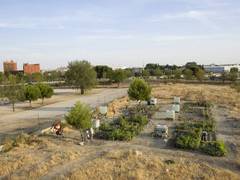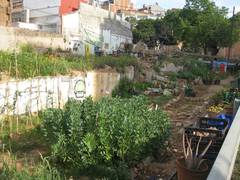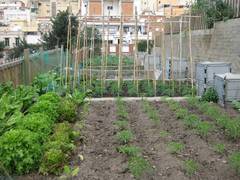Case studies Spain
Assessing and valuing ecosystem services provided by urban allotment gardens
Ecosystem services, i.e. benefits humans derive from ecosystems by urban allotments is increasingly highlighted in the literature as a means of improving quality of life in cities. These services may include quality food production, social cohesion, recreation, environmental learning and education, therapeutic values, and as a source of resilience, especially during crises. The objective of the research is to identify, characterize, and value the ecosystem services provided by urban allotment gardens to support decisions by urban planners and practitioners. The research is based in urban gardens of the municipalities of Madrid (n= 29) and Barcelona (n=29). Identification and characterization of ecosystem services is based on a combination of methods, including literature review, participant and non-participant observation and semi-structured interviews. Ecosystem services valuation is based on a survey to assess the perceived importance by the beneficiaries of urban allotment gardens. We expect our research to provide important insights for academics, policy makers and practitioners on the importance of urban allotment gardens for well-being in cities. Our results could also contribute to better integrate urban allotment gardens in municipal policies on urban green space.
Supporting Organizations: ICTA-UAB, LSES-UAM, Biodiversas, MICINN, Red de Huertos Urbanos Comunitarios de Madrid, Xarxa d’Horts Urbans Comunitaris de Barcelona, Xarxa d’horts urbans de Barcelona.
List of Case Studies in Barcelona
Hort del Forat de la Vergonya
Hort del Xino
Hort Sant Pau del Camp
Hort del Fort Pienc
Hort Sagrada Familia
Hort Vallcarca
Hort el Jardí
Hort de l’Avi
Hort Turull
Hort Masia Can Soler
Hort Camí de Torre Melina
Hort Pedralbes
Hort Can Masdeu
Hort Can Peguera
Hort Casa de l’Aigua
Hort de Poblenou
Hort Poblesec
Aki me planto-Sant Andreu
Horts Maladeta
Hort Trinitat
Hort de la La Farga - Sants
Hort Masia Can Mestres
Hort Collserola
Hort Comunitari del Clot
Hort Masia Can Cadena
THE URBAN GARDENS IN ANDALUSIA (SPAIN)
Description
In Spain, some of the best examples of urban gardens can be found in Andalusia. This region is pioneer in the creation, development and management of this type of land exploitation (for instance, the Miraflores Park in Seville).
Moreover, Andalusia gathers different and varied types of landscapes, from urban areas such as Seville, Malaga and Cadiz Bay to countryside, meadows, mountain ranges and coastal sceneries. This offers the possibility to work with different kinds of urban gardens and therefore developing in different scales.
It should be noted that, from 2008, due to the economic crisis in Spain and the growth of unemployment (with numbers around 27%) an explosion of urban gardens in Andalusia has produced, going from 20 gardens throughout the region to over 200 at present.
Before the economic crisis, citizens were the ones to promote the creation of urban gardens. This tendency changed in 2008, as some municipalities and regional governments found in urban gardens a temporary solution to counteract the economic and social problems that affected the population.
However, despite of the fact that Andalusia has numerous good examples of urban gardens, there is no inventory, catalog or registration of urban gardens; no one has studied its evolution, present or future behavior, etc.
Objectives
Theoretical objectives:
1. Epistemologically clarify the terms "urban garden" and "urban agriculture" and deepen their multiple meanings in Andalusia.
Objectives Grounds:
2. Study the historical development of urban gardens and the circumstances that lead to its emergence in recent years in Andalusia.
Objectives of application:
3. Carry an identification, description and analysis of existing urban gardens in Andalusia today.
4. Point out the similarities and differences between these orchards experiences.
5. Know about the current problems and future projects of these gardens in Andalusia.
Propositional Objectives:
6. Propose formulas for the creation, design and management of new urban gardens from a social perspective.
Methodology
In general, urban gardens are a multifaceted phenomenon and that can be viewed from different perspectives. Looking from a single discipline or a single view makes it difficult to understand all of this polyhedron. Therefore, it is necessary to look at it from different perspectives:
- From a social perspective, because different social profiles can be found in urban gardens: from people coming from rural areas to those with no previous links with the countryside but with a high environmental awareness and a strong feeling for the rural world.
- From an economic perspective, as urban gardens represent large areas of the planet as a resource to obtain food for millions of people. In Third World cities, the existence of urban gardens supposes the improvement in the familiar economy and therefore in life quality. The impact on the micro-economics or "home economics" is remarkable.
- From an urban-territorial perspective, as a phenomenon that it is being introduced in the local development plans and as a new way to “”build city up". However, some urban planners do not deal with it: "Most cities reject agriculture particularly within the urban development, as something that is incompatible with the urban landscape" (Cruz M., 1995).
- From an environmental perspective, since urban gardens are a growing phenomenon that can reduce urban footprint and counteract the excesses of environmental degradation in cities.



